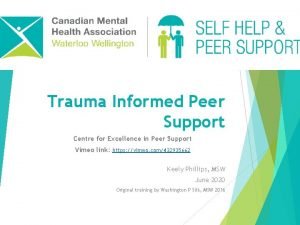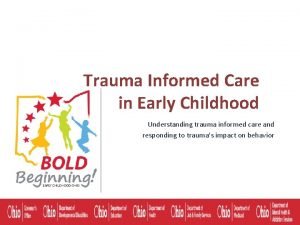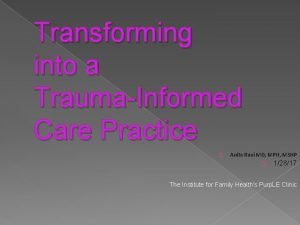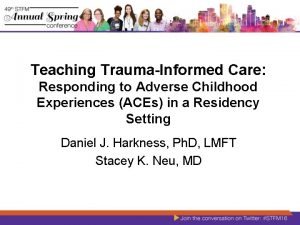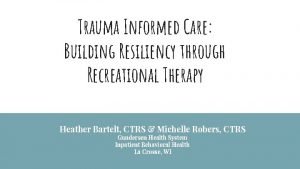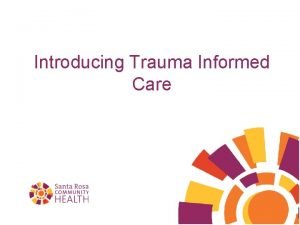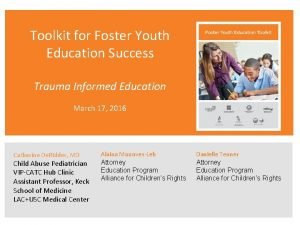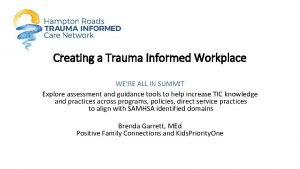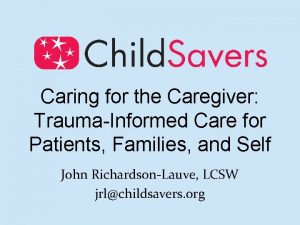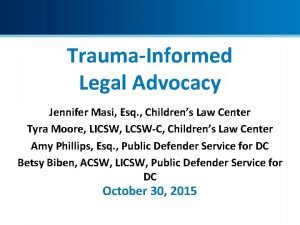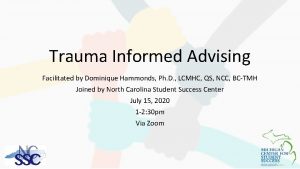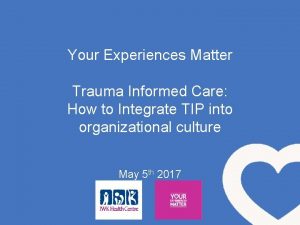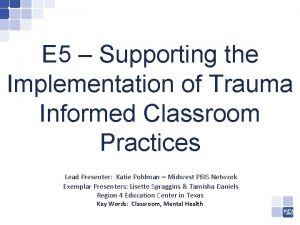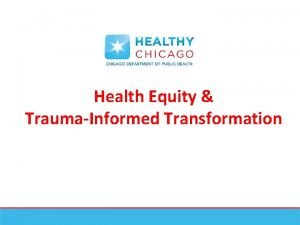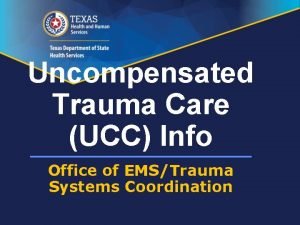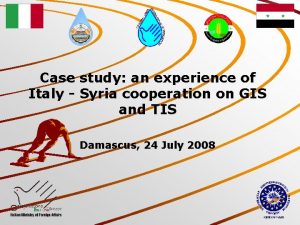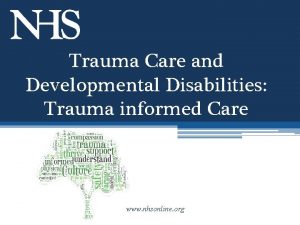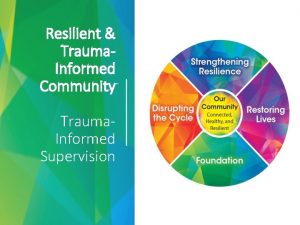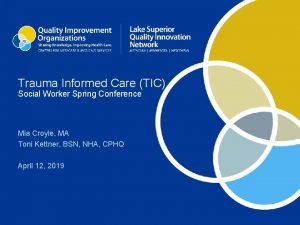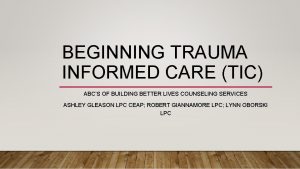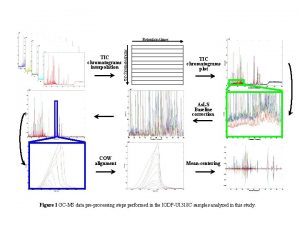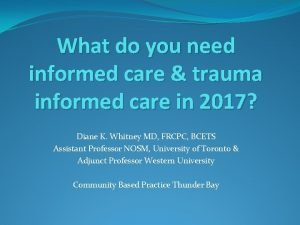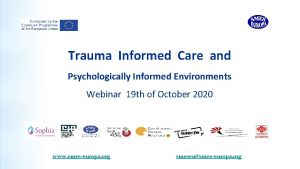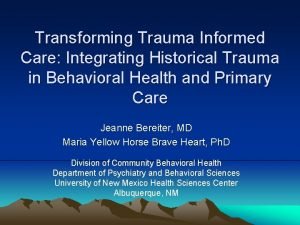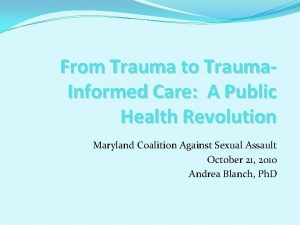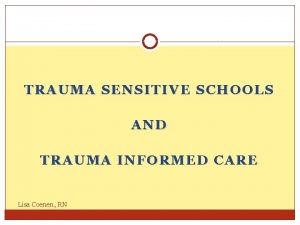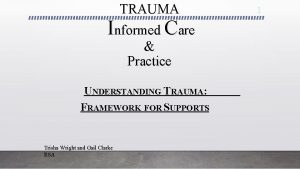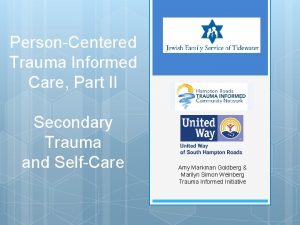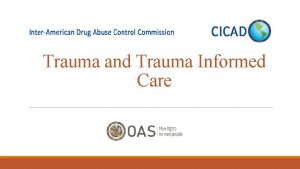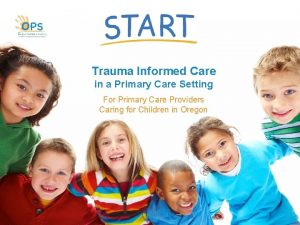Trauma Informed Support TIS Trauma Informed Care TIC








































- Slides: 40

Trauma Informed Support (TIS) Trauma Informed Care (TIC)

Rationale for the session Long term factors just as important as immediate triggers. Often those factors are just not known by support staff‐ histories lost or discounted Negativity towards ‘damaged’ people: ‘He knows exactly what he is doing’ ‘She’s just doing it for attention’

Background for session • Previous experience of delivering sessions about Trauma Awareness • Literature examined‐ Quite a lot but not much relating to people with LD • Own level of knowledge/education‐ not an expert‐ trying to teach myself on the subject

Aims and objectives of the session Aim‐ to increase awareness and understanding of TIS and what is helpful to support people who have experienced traumatic events. Objectives • Achieve a greater understanding of what constitutes a traumatic event for people we support and how they might be affected • Examine barriers for supporting someone who has experienced trauma • Achieve a greater understanding of what is helpful in supporting someone who has experienced trauma

Links to PBS Links with PBS Academy principles: • Importance of a data driven approach • Functional analysis • Need for a multi‐ component approach • Need for a long term approach

Link to behaviours that challenge Self‐harming has been described as a "physical expression of emotional distress". Some people find that the physical act of hurting themselves helps them deal with overwhelming emotional and psychological issues. NHS Choices website

Activity In groups or pairs or individually, reflect on what constitutes a traumatic event for anyone, but particularly the people we support and feedback examples Examples identified: Institutional abuse; regimented routines; impact of school closures; care home closures; losses of all types‐ relationships; bereavements, experiencing or witnessing violence; restraint and seclusion; withdrawal by people who are meant to be supporting; bullying including on line bullying; perceived threats triggered by past experiences; rejection by sectors of society; adverse childhood experiences; loss of identity, loss of job; neglect including not being nurtured in early years • People perceive their experiences differently depending on factors such as at what point in someone’s life things occur and their current ability to cope. • Trauma is in the ‘eye of the beholder’‐ subjective but real • Sometimes people learn the wrong skills to help them cope with things • If you are not in control traumatic events are worse •

What constitutes a traumatic/adverse life event ‘Trauma results from an event, series of events, or set of circumstances that is experienced by an individual as physically or emotionally harmful or threatening and that has lasting adverse effects on the individual’s functioning and physical, social, emotional, or spiritual wellbeing (Substance Abuse and Mental Health Services Administration [SAMHSA], 2012, p. 2). ’ Trauma is subjectively defined by the person who has experienced the event in question‐not by objective parameters or definitions – should we extend definition/understanding of Trauma to what an outsider might regard as quite a minor event

What constitutes a traumatic/adverse life event? Examples of adverse life events are illness, injury, accident, hospitalization, being sectioned, being a victim of theft or crime, witnessing crime, perpetrating crime, bereavement, the breakup of a relationship, sexual abuse, loss of occupation, serious illness of a close relative, or moving from a long hospital stay

Adverse Childhood Experiences • parents divorcing or separating • living with a parent who is depressed or suffers mental illness • living with a parent who is an addict (alcohol, drugs or otherwise) • witnessing a parent being abused or mistreated • verbal abuse/emotional and humiliation • emotional neglect • physical abuse • sexual abuse • a family member going to jail.

Examples for the people we support • • Change of staff Change of key worker New resident Change at work/day service Death of sibling/parent/close relative Major illness in friend/care giver/relative Changes in frequencies of family/friend visits Major illness

An example for real life • Born in a deprived part of the city • Disrupted family life‐ brought up mainly by older sister • Attended Convent School‐ beaten by nuns • Lived rough for at least a few months as a young man • Spent time in prison

Example continued • Developed Schizophrenia as a young man • Lived in a long stay hospital for several years • Tried living in a supported flat but didn’t work out so moved to a care home. • Had a relationship with a girlfriend not supported by his family or his consultant • Had a stroke later in life and had to leave the home where he had lived for nearly 30 years

Another example • Went to live in a long stay hospital at the age of 10 • Severely sexually abused when transferred to a hospital where predominately adult males lived • Routinely physically abused and bullied by more able people • Lost his father, loss of ability to spend time at the family home • Mental health/physical health problems

One more • • Has Fragile X Teased and bullied at school Excluded from school at age of 14 Excluded from college by age of 18 Excluded from Day Care service by age of 19 Left home to live in residential care when 19 Father having a long term disabling illness

Extent of trauma in people’s lives • 79% of people with LD experience some form of traumatic event (Scotti et al 2012)Most were exposed to more than one traumatic event 2. 9 more likely to have emotional abuse 3. 4 more likely to have physical abuse 5. 3 more likely to be neglected 6. 4 more likely to be sexually abused (Spencer et al 2005)

Extent of Trauma/abuse • 1 in 4 children with learning disabilities experience maltreatment • People with LD four times more likely to experience physical, emotional or sexual abuse • More likely to have experienced adverse life events if supported by paid carers‐ e. g. more likley to be exposed to aggression or witness aggression • Reported rates likely to be distorted due under reporting or lack of recognition

Impact of ACEs on physical and mental health • Correlation between ACEs and physical health problems such as COPD, Liver disease, cancer, Crohn’s disorder, obesity • Developmental trauma impairs the ability of the brain to regulate emotions, preparing brain for survival rather than learning • Abuse/trauma‐ risk factors for PTSD/ Emotionally Unstable Personality Disorder (Borderline Personality Disorder)/Schizophrenia • Difficulties with relationships

Relationship to PTSD Interpersonal violence/sexual assault‐ types of trauma that are more likely to lead to PTSD • Avoidance of thoughts and discussions about traumatic events • Recurrent and intrusive thoughts/ flashbacks • Associated with long term development of anxiety, depression and mood disorders

Impact of trauma on the body • Exposure to ACEs can affect brain development • Danger of hyperarousal over lifetime span hindering person’s ability to assess threat/trauma • Danger that it will affect levels of engagement with others leading to heightened responses to perceived threats or ‘freeze’ responses

Video clips‐impact of Trauma https: //www. youtube. com/watch? v=Mp‐ Q_UU 6 Ksk https: //www. youtube. com/watch? v=a‐ dd. SEHRWVg

Barriers • Therapeutic – lack of evidence based options specifically for our client group; need to adapt approaches developed for use with the general population • Organisational‐ organisations and teams not having the knowledge of trauma and its impact; staff turn over and resources for training • Personal – difficulties with memory and understanding

Barriers • Diagnostic Overshadowing= assuming that the behaviours associated with PTSD are cuased solely by the person’s LD • Stress Contagion ‘Caring for patients is itself emotionally challenging and can evoke providers’ own grief, sadness, anger, and even symptoms of vicarious PTSD. ’ Over preoccupation, over involvement, interpersonal withdrawal…… Disproportionate impact of staff in people’s lives; lack of networks…….

Activity • What do you think might help people who have experienced trauma? What barriers might there be for introducing TIS/TIC principles and approaches? Helpful approaches/strategies Relevant staff training especially for direct support staff; raising awareness of the issue of trauma in people’s lives‐ normalising the issue in the sense of keeping it open by frank discussions; ensure support for staff as knowledge of traumas might impact on their well being; awareness of limitations of roles; regular meetings and supervisions; no punitive approaches; establish blame free cultures; build trusting environments; building environments where people feel safe; Empowering people; helping people to identify the trauma that has happened in their lives; establish environments where compassion predominates and people are listened to. Establish environments where people feel safe; help staff to maintain their compassion in the face of behaviour that challenges; maintain staff well being Barriers Supporting people who have experienced trauma may lead to strong emotions‐ are we equipped to deal with those emotions in ourselves and the people we support?

Principles of Trauma Informed Support Assume that everyone we support has experienced some trauma • Realising the impact of Trauma • Recognising the signs and symptoms of trauma in individuals • Integrating knowledge of trauma into policies, procedures and practices • Actively seeking to avoid traumatisation

Video clip‐What is Trauma Informed Support? https: //www. youtube. com/watch? v=f. Wken 5 Ds. J cw

Another perspective • Ensure that people feel safe and secure • Trustworthiness and transparency‐make policies and decisions in an open way • Peer Support‐mutual self help‐ reduce burnout • Collaboration‐ sharing power • Empowerment Voice and Choice • Addressing Cultural. Historical and Gender issues

Another perspective • Creating physical and emotional safety • Creating Trustworthiness • Providing clients with a sense of control by giving choice • Collaboration • Empowerment

Personal view • Teams develop great empathy and much more positive approach from knowing the detail and extent of traumatic experiences. • Knowing the detail helps you devise specific approaches to help address specific traumas

Specific therapeutic approaches • • • Trauma focussed CBT Eye Movement Desensitisation Reprocessing Exposure Therapy PBS planning Compassion based therapy

Other strategies • Ensure that we recruit staff who are empathic, non judgemental and collaborative in their approach. • Pay attention to environments‐ avoid noise, commotion and chaos

Developing Resilience Once thought of as an innate capacity that people either had or lacked, it is now considered a human competency that can be developed and strengthened through ordinary human adaptation and environmental supports (Maslen, 2001). Genuine resilience to potentially traumatic experiences is not rare but common

Developing resilience • • Healthy attachments to caring people Purposeful activities Stimulating environments Teaching self regulation

Measuring organisational TIC support (TICOMETER) 5 domains • Building trauma informed knowledge and skills (5 items) • Establishing Trusting Relationships (8 items) • Respecting service users (6 items) • Foster Trauma Informed Delivery (10 items) • Promoting Trauma Informed procedures and policies (6 items)

Bibliography Natalie R. Stevens, Maisa S. Ziadni, Teresa A. Lillis, James Gerhart, Courtney Baker & Stevan E. Hobfoll (2019) Perceived lack of training moderates relationship between healthcare providers’ personality and sense of efficacy in trauma‐informed care, Anxiety, Stress, & Coping, 32: 6, 679‐ 693, Renee Fredrickson (2019) Trauma‐Informed Care for Infant and Early Childhood Abuse, Journal of Aggression, Maltreatment & Trauma, 28: 4, 389‐ 406 Achieving Service Change Through the Implementation of a Trauma‐ Informed Care Training Program Within a Mental Health Service Nicola Palfrey Rebecca E. Reay Velissa Aplin · Jeffery C. Cubis Virginia Mc. Andrew Denise M. Riordan Beverley Raphael Community Mental Health Journal (2019) 55: 467– 475 Organizational Trauma‐Informed Care: Associations With Individual and Agency Factors George Jay Unick Ellen L. Bassuk Psychological Services 2019, Vol. 16, No. 1, 134– 142

Bibliography Workplace violence perpetrated by clients of health care: A need for safety and trauma‐informed care Jill Beattie , Debra Griffiths , Kelli Innes , Julia Morphet Journal of Clinical Nursing Volume 28, Issue 1‐ 2 Pages: 1‐ 361 (2019) Do You Provide Trauma‐Informed Care? Chad Rogers ASBN Safe and Collaborative Communication Skills: A Step towards Mental Health Nurses Implementing Trauma Informed Care Sophie Isobela, Cynthia Delgadoa Archives of Psychiatric Nursing April 2018 Volume 32, Issue 2, Pages 291– 296 Effectiveness of six core strategies based on trauma informed care in reducing seclusions and restraints at a child and adolescent psychiatric hospital Muhammad Waqar Azeem , Akashdeep Michelle Rammerth , Gary Binsfeld , Robert B. Jones Journal of Child and Adolescent Psychiatric Nursing. 2011 Feb; 24(1)

Bibliography Knowledge, Principal Support, Self‐Efficacy, and Beliefs Predict Commitment to Trauma‐Informed Care Stephanie A. Sundborg. Psychological Trauma: Theory, Research, Practice, and Policy 2019, Vol. 11, No. 2, 224– 231 Trauma‐Informed Care Are We There Yet? Pam Greene Texas Nursing Magazine; Spring 2018 p 8 Trauma‐Informed Care Catherine C. Claassen and Carrie S. Clark Chapter 5 In S. N. Gold (Ed. ), APA handbooks in psychology®. APA handbook of trauma psychology: Trauma practice (p. 515– 541). American Psychological Association. Developing an Instrument to Measure Organizational Trauma‐ Informed Care in Human Services: The TICOMETER Ellen L. Bassuk George J. Unick Psychology of Violence 2017, Vol. 7, No. 1, 150– 157

Bibliography Trauma‐Informed Care: An Intentional Approach Jessika Boles The Children's Corner: Perspectives on Supportive Care Pediatric Nursing/September‐October 2017/Vol. 43/No. 5 251 A Call for the Integration of Trauma‐Informed Care Among Intellectual and Developmental Disability Organizations John M. Keesler Journal of Policy and Practice in Intellectual Disabilities Volume 11 Number 1 pp 34– 42 March 2014 Trauma‐informed health care: Its time is now Margaret Paccione‐Dyszlewski, The Brown University Child and Adolescent Behavior Letter December 2018 Supervision for Trauma‐Informed Practice Roni Berger and Laura Quiros Traumatology 2014, Vol. 20, No. 4, 296– 301

Bibliography Risk of Violence by Inmates With Childhood Trauma and Mental Health Needs Michael S. Martin Gordana Eljdupovic Kwame Mc. Kenzie Ian Colman Law and Human Behavior 2015, Vol. 39, No. 6, 614– 623 First, do no more harm: ethics of attending to spiritual issues in trauma treatment. Christine A. Courtois in Spiritually Oriented Psychotherapy for Trauma, D. F. Walker, C. A. Courtois, and J. D. Aten (Eds) 2015 American Psychological Association Toxic Stress, Behavioral Health, and the Next Major Era in Public Health David L. Shern, Andrea K. Blanch and Sarah M. Steverman American Journal of Orthopsychiatry 2016, Vol. 86, No. 2, 109– 123

Bibliography Trauma‐informed care: A qualitative study exploring the views and experiences of professionals in specialist health services for adults with intellectual disabilities. Maria Truesdale, Michael Brown, Laurence Taggart , Aoife Bradley , Douglas Paterson, Chammy Sirisena , Robert Wall Thanos Karatzias Journal of Applied Research in Intellectual Disabilities Volume 32, Issue 6 November 2019 Pages 1437‐ 1445
 Trauma informed peer support
Trauma informed peer support 4 r's trauma informed care
4 r's trauma informed care Trauma informed care lgbtq
Trauma informed care lgbtq 4 r's trauma informed care
4 r's trauma informed care 4 r's trauma informed care
4 r's trauma informed care 4 r's trauma informed care
4 r's trauma informed care Libby bergman
Libby bergman Tina champagne sensory modulation and environment
Tina champagne sensory modulation and environment Trauma informed practice
Trauma informed practice Trauma informed icebreakers
Trauma informed icebreakers Trauma informed care for foster youth
Trauma informed care for foster youth Trauma informed workplace
Trauma informed workplace Trauma-informed questions for clients
Trauma-informed questions for clients Jennifer masi
Jennifer masi Trauma informed advising
Trauma informed advising Acessexual
Acessexual Trauma informed practice
Trauma informed practice Trauma informed physical environment
Trauma informed physical environment Trauma informed practice
Trauma informed practice Primary secondary tertiary care definition
Primary secondary tertiary care definition Uncompensated trauma care application texas
Uncompensated trauma care application texas Total care orthopedics
Total care orthopedics M s t mus tis nt
M s t mus tis nt Hymn 524
Hymn 524 Tis 455
Tis 455 Imacs tis
Imacs tis Hamlet 5th soliloquy
Hamlet 5th soliloquy Tis irrigation
Tis irrigation Where jesus is tis heaven there
Where jesus is tis heaven there Tis bus
Tis bus Tis 455
Tis 455 What is tis?
What is tis? Tis all a checkerboard of nights and days
Tis all a checkerboard of nights and days Tis granules
Tis granules Famous lines from macbeth
Famous lines from macbeth 恩典夠我用 永不感力窮
恩典夠我用 永不感力窮 Tis true my form is something odd
Tis true my form is something odd Title of jesus
Title of jesus Where jesus is tis heaven there
Where jesus is tis heaven there Tis macce
Tis macce Tis report
Tis report
